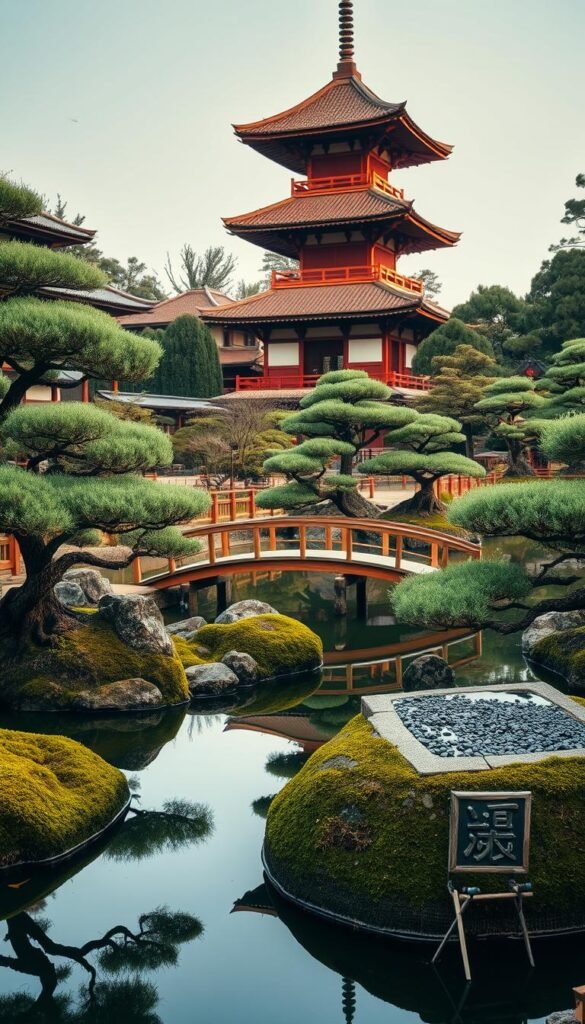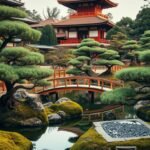Imagine stepping into a space where every stone, plant, and water feature feels perfectly placed. This harmony didn’t happen by accident. For over 1,400 years, Japanese garden traditions have shaped outdoor spaces to mirror nature’s rhythms while reflecting cultural values.
These living artworks began as spiritual expressions – attempts to capture humanity’s essential connection with the environment. Like ancient Chinese landscape painters, designers sought to distill nature’s essence rather than copy it outright. Today, this philosophy resonates globally as people crave meaningful connections with outdoor spaces.
You’ll find these principles reimagined in urban parks, backyard retreats, and commercial properties. Some interpretations honor traditional methods, while others adapt concepts like “borrowed scenery” or asymmetrical layouts for contemporary needs. The best designs balance aesthetic appeal with psychological restoration.
What makes these ideas endure? They answer a universal longing – the need to escape rigid structures and reconnect with organic beauty. Whether through carefully placed moss gardens or strategic sightlines, design principles born in medieval Japan still help modern landscapes feel both intentional and alive.
Exploring the Rich History of Japanese Garden Design
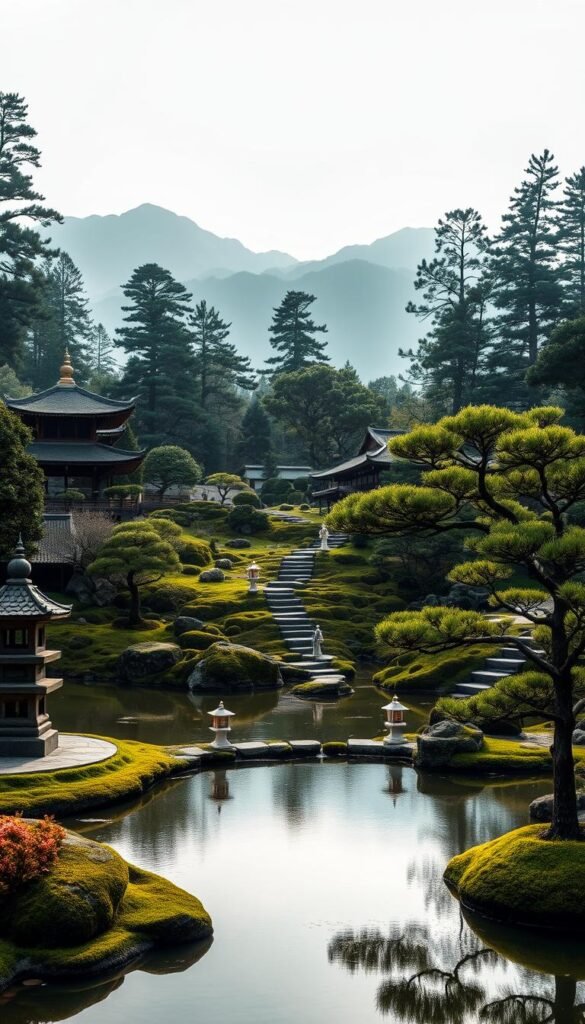
Centuries-old traditions shape how we experience outdoor spaces today. Did you know the first written guide for creating gardens appeared in Japan nearly 1,000 years ago? The Sakuteiki, or “Records of Garden Making,” laid groundwork still referenced by landscape artists worldwide.
Legacy from the Heian Era to Modern Times
During the Heian Era (794–1185), aristocrats built sprawling shinden gardens with artificial lakes and pavilions. These spaces symbolized power and mirrored China’s Tang Dynasty aesthetics. By the 14th century, dry landscapes (karesansui) emerged, using gravel and stones to represent oceans and mountains.
The Momoyama Period (1568–1600) introduced tea gardens with winding paths leading to rustic tea houses. Edo-era stroll gardens later blended water features, bridges, and curated views. After 1868, Western elements like flower beds merged with classic designs without losing their core identity.
Evolution of Shinden, Zen, and Tea Gardens
Each garden style reflects its era’s values. Shinden layouts prioritized ceremony, while Zen spaces encouraged meditation through minimalism. Tea gardens transformed functional pathways into artistic journeys, proving practicality and beauty coexist.
| Era | Garden Type | Key Innovation |
|---|---|---|
| Heian (794–1185) | Shinden | Large ponds, symmetry |
| Kamakura (1185–1333) | Zen dry landscapes | Abstract rock arrangements |
| Momoyama (1568–1600) | Tea gardens | Stepping stones, lanterns |
| Edo (1603–1868) | Stroll gardens | Curated viewpoints |
Notice how each period added layers of meaning? Stones became metaphors, water symbolized life’s flow, and empty space turned into a design element. These choices still inform how we shape meaningful landscapes today.
Understanding Core Elements in Japanese Garden Design
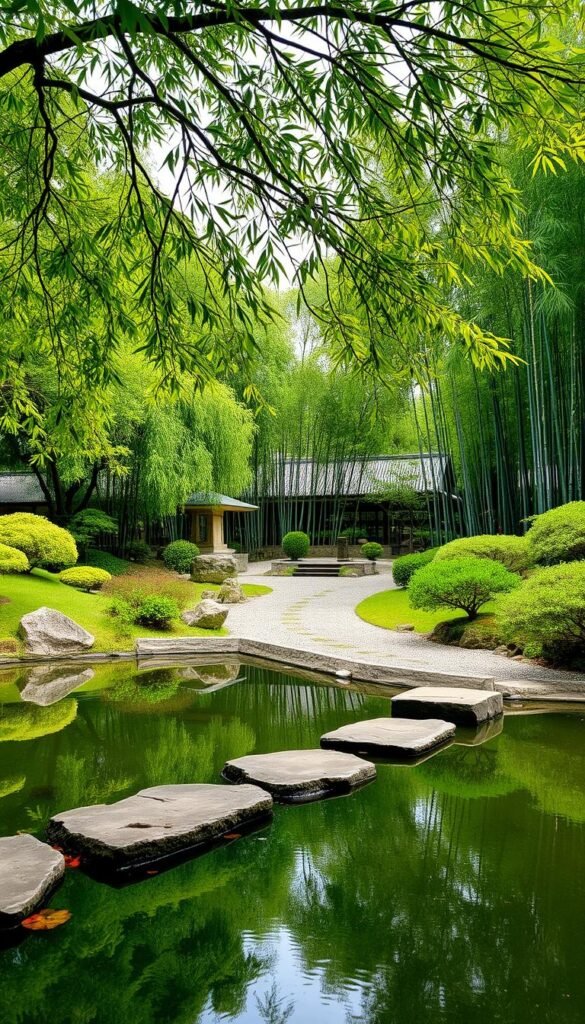
Creating a garden that feels both timeless and alive starts with understanding its bones. Three elements form the foundation: stones shape structure, water brings movement, and trees add vertical rhythm. Together, they create spaces where every detail whispers “this belongs here.”
Stones, Water, and Natural Trees
Stones act as anchors. The ancient Sakuteiki teaches that placing rocks isn’t decoration – it’s storytelling. A vertical stone becomes a mountain. Flat ones form riverbeds. Even gravel patterns mimic ocean waves when raked thoughtfully.
Water flows through designs literally and symbolically. Streams curve like calligraphy strokes. Ponds mirror skies. Dry arrangements use white sand or pebbles to suggest waterfalls. You’ll often hear water before seeing it – a trick that builds anticipation.
Trees complete the triad. Maples frame autumn views. Pines add winter texture. Pruned junipers mimic windswept cliffs. Their heights balance low stone clusters, creating natural ceilings that filter sunlight.
Creating Harmony with Everyday Landscape Elements
Great designs make ordinary materials extraordinary. Moss transforms stepping stones into floating islands. Bamboo fences turn functional barriers into art. Even empty space matters – what you don’t plant lets key features breathe.
| Element | Practical Role | Symbolic Meaning |
|---|---|---|
| Vertical Stones | Create focal points | Mountain peaks |
| Curved Water | Guide movement | Life’s flow |
| Pruned Trees | Control scale | Human-nature balance |
| Raked Gravel | Define areas | Ocean waves |
Notice how each piece plays multiple roles? A single rock can mark a path and represent a sacred site. Your goal isn’t copying nature – it’s sparking that deep “aha” moment when arrangement feels inevitable.
Timeless Design Principles and Aesthetic Guidelines
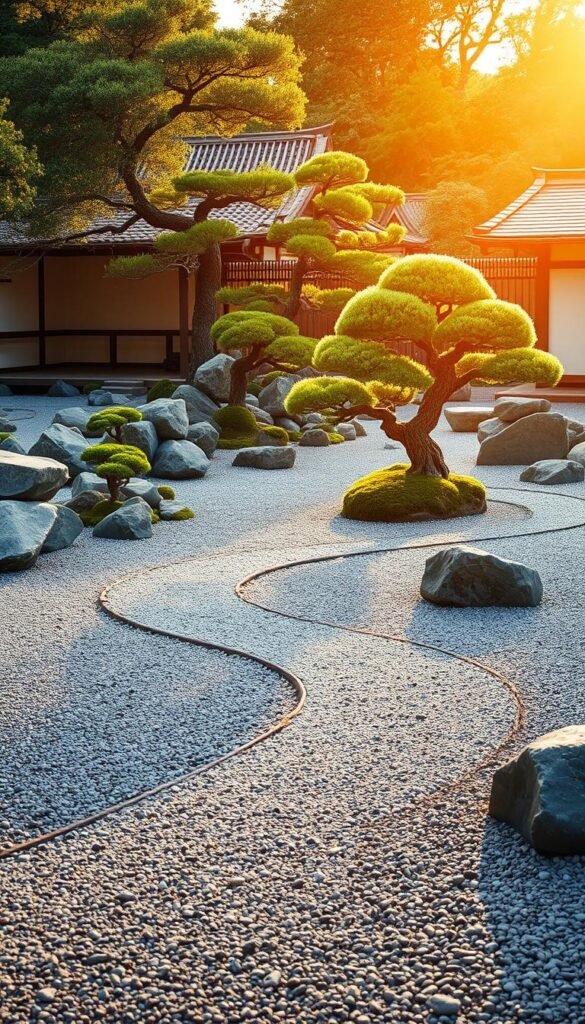
What makes a garden feel alive yet perfectly balanced? The answer lies in design principles that celebrate nature’s irregular rhythms. Unlike Western symmetry, these rules prioritize organic flow over rigid perfection.
Asymmetry, Simplicity, and the Golden Ratio
Asymmetry tricks the eye into seeing spontaneity. A crooked path or off-center lantern creates dynamic energy. Pair this with simplicity – using fewer elements intentionally – and you craft spaces that breathe.
Nature’s favorite math shows up everywhere. The Golden Ratio (1:1.618) guides rock groupings and plant spacing. A 15th-century manual called Illustrations reveals this proportion in stone arrangements, proving beauty has formulas.
The Role of Proportion and the Three Forces
Three directional planes shape emotional responses:
- Horizontal lines (decks, low walls) calm the mind
- Vertical elements (tall stones, trees) add drama
- Diagonal angles (bridges, raked gravel) inject movement
Master these forces, and you’ll design gardens that feel both wild and purposeful. Want deeper insights? Explore the art of Japanese garden design through hands-on examples.
The Influence of Japanese Garden Design Principles on Modern Landscapes
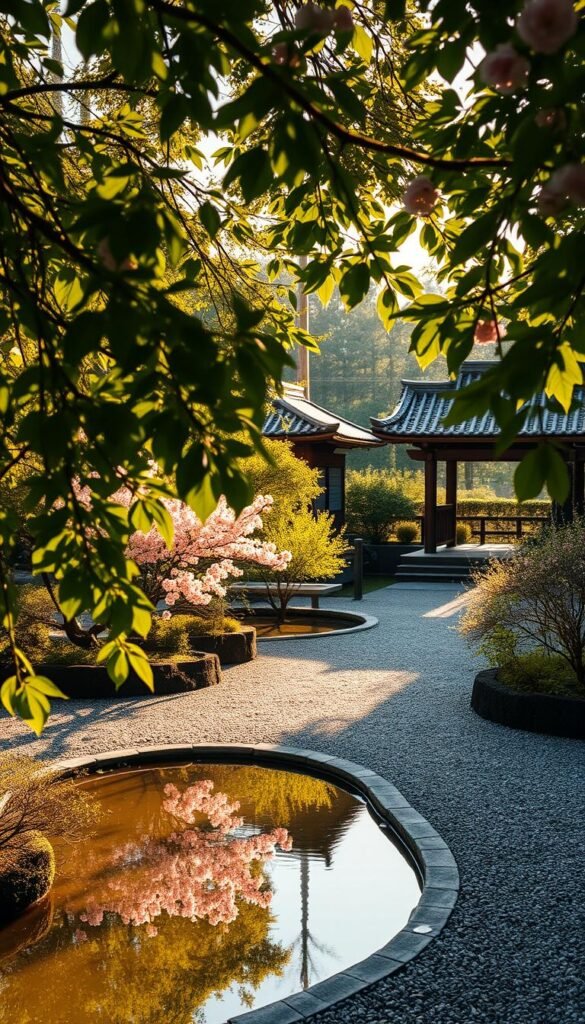
Creating spaces that feel both rooted and relevant requires navigating two distinct philosophies. One leans on textbook formulas, while the other breathes new life into ancient ideas through creative adaptation.
Authenticity Versus Stereotypical Approaches
Some gardens use Japanese design elements like checklists. Picture imported stone lanterns or maple trees forced into unsuitable climates. These literal interpretations often feel disconnected from their surroundings. A billionaire once shipped 500 orchid trees to recreate a “perfect” garden, only to create a landscape that felt like a museum exhibit.
True artistry emerges when designs respond to their environment. The Daisen-in garden revolutionized rock arrangements to mimic ink paintings. Instead of copying old layouts, it translated artistic concepts into living spaces. This approach blends tradition with local materials and user needs.
| Approach | Focus | Outcome |
|---|---|---|
| Formulaic | Replicating elements | Disconnected landscapes |
| Contextual | Site-specific solutions | Integrated experiences |
Modern garden designs thrive when they honor principles, not prescriptions. Urban parks might use asymmetrical gravel patterns instead of koi ponds. Residential spaces could replace traditional gates with native shrubs. The goal? Craft environments where every choice carries meaning.
Your backyard doesn’t need imported elements to channel this philosophy. Focus on how sunlight dances through local foliage or how winding paths create discovery. That’s where timeless designs meet contemporary life.
Planning Your Japanese Garden: Process and Practical Tips
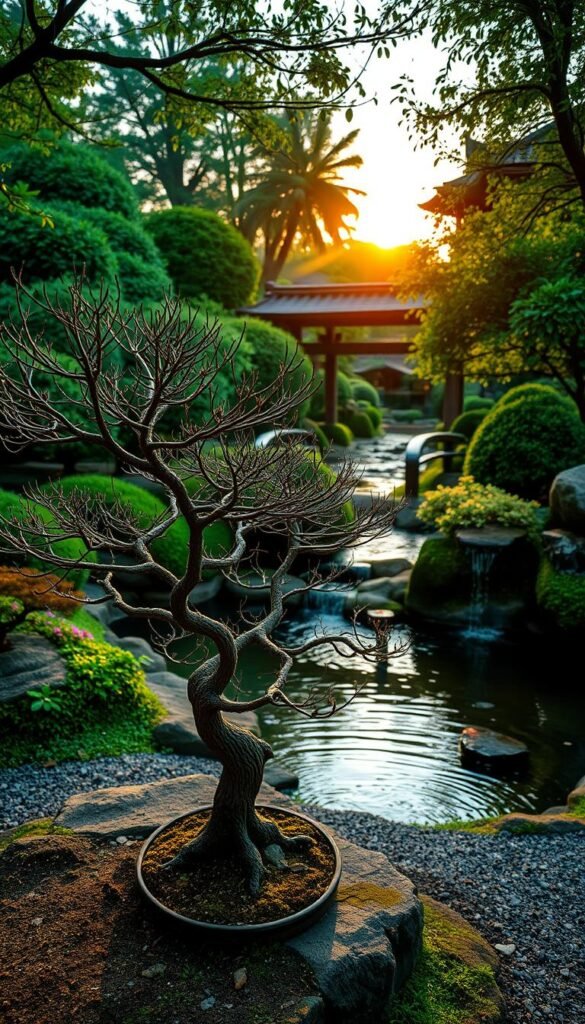
Crafting your ideal outdoor space begins with listening—to the land, your needs, and what materials whisper. The Accord Triangle framework helps balance these voices. Unlike rigid templates, this approach adapts to your unique situation while honoring timeless principles.
Leveraging the ‘Accord Triangle’ for Site-Driven Design
Think of the triangle’s three points: your vision, the site’s personality, and local resources. A sloped backyard might become a cascading waterfall garden using native stones. Urban balconies could transform into Zen retreats with container plants and pebble mosaics.
| Triangle Element | Key Questions | Design Impact |
|---|---|---|
| Personal Needs | Do you seek relaxation or entertainment? | Shapes layout and features |
| Site Conditions | Where does sunlight linger? Wind patterns? | Determines plant choices |
| Local Materials | What stones/plants thrive here? | Defines aesthetic authenticity |
Utilizing Locally Available Materials and Natural Ambience
Swap imported lanterns for regional granite. Use prairie grasses instead of traditional bamboo if that’s what grows wild nearby. As landscape designer Julie Moir Messervy notes: “True harmony emerges when materials sing their native song.”
Start by mapping your space’s natural rhythms. Track morning light patterns. Note where rainwater pools. These observations become your blueprint. A mossy northwest corner? Perfect for a fern grotto. Sunny southern exposure? Ideal for flowering shrubs.
Remember, planning becomes poetry when you let the land lead. Your finished garden won’t look like Kyoto—and that’s the point. It’ll feel like home.
Creative Integration of Japanese Design Elements in Your Outdoor Space
Crafting a personal oasis involves more than just plants—it’s about intentional design. Let’s explore how to blend tradition with modern needs using three key features: tea-inspired spaces, functional artistry, and sustainable choices.
Pathways to Peace: Tea Gardens and Stepping Stones
Create intimate tea garden zones using winding paths and irregular stepping stones. These elements evolved from muddy 15th-century solutions to modern focal points where beauty outweighs function by 60%. Frame distant views through shakkei (borrowed scenery), making neighboring trees or hills part of your layout.
Eco-Friendly Expressions
Modern adaptations thrive when sustainability meets creativity. Use reclaimed barn stones for water basins or native grasses instead of traditional bamboo. As designer Samuel Newsom advised: “Include only what enhances the scene’s beauty.” Your space becomes uniquely yours while honoring timeless principles.
Whether adding a contemplation corner or reimagining walkways, let materials and surroundings guide your vision. The result? A garden that feels connected—to nature, history, and your personal story.

